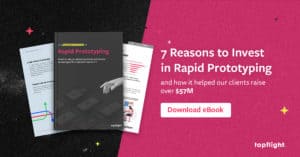As a founder, time is your most valuable resource. While a simple online search will lead you to a plethora of guidelines and tips for creating a perfect mobile application UI design, filtering out the useful content from the noise is a tough task. After experiencing this first hand, we have created a comprehensive mobile application design guide that will serve as the only blueprint you need in your pursuit of creating a knockout app. Our mobile UI design guideline will help you design an app perfectly tailored to your customers’ needs.
Top Takeaways:
- The general mobile app design guideline includes prototyping, user testing, getting feedback from a multidisciplinary team (UX/UI/developers/marketers), assessing accessibility options, and carefully applying the latest mobile design principles.
- During the application design process, the most commonly overlooked issues are empty state (the lack of a user-friendly UI when no data is available), incohesive visual hierarchy, and counterintuitive navigation.
- Any app design guide would be incomplete without touching on the main UX principles, including Hick’s Law, Parkinson’s law, KISS principle, color theory, and cognitive load management at the bare minimum.
Table of Contents
- Step 1: The importance of User Testing
- Step 2: App design is not a solo mission
- Step 3: Be aware of the latest mobile app design and development trends
- Step 4: Design with the user in mind
- Step 5: Understand the science and apply it
- Step 6: Perfecting the in-app experience
- Step 7: Future proof your mobile app interface design
Step 1: The importance of User Testing in your app design process
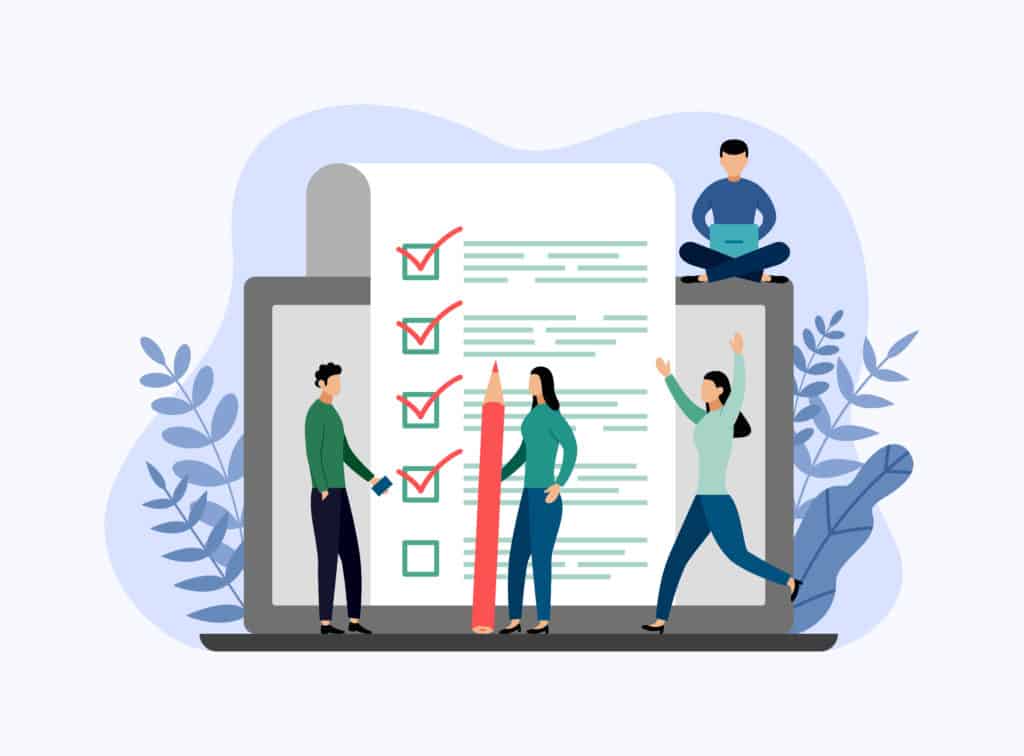
There’s no way we can list all mobile application design process steps without mentioning user tests. User testing lies at the very heart of the app design process. We simply cannot emphasize this point enough. During user testing, a prototype of the app is given to real users to test. Their feedback and pain points are noted down and based on that, the next iteration of the prototype is made. It is a quick and cheap way to test the design and functionality of the app so designers and developers can further improve it and design a mobile app UI/UX that elevates user engagement.
As a founder, I found out the hard way how important it is to do proper user testing early on. We had this idea for a booking app that connects people with the nearest barber and allows them to make appointments. We jumped right into designing the app, perfecting the design, without actually allowing real users to test the UI elements. After months of work, the app was launched. All our assumptions regarding the user’s needs were shattered. People were skeptical about the value proposition.
Faced with this situation, we decided to review our mobile app UX design process. We conducted user surveys and interviews. We asked people to try out the service and recorded their feedback. Analysis of the results led us to the following conclusion:
- Most people already have a go-to barber that they trust. They do not like to experiment with new individuals.
- In this case, an app was just adding an extra hassle in an already simple process.
- Users preferred booking an appointment with their barber over a phone call, text message or WhatsApp instead of doing it through the app.
- Even if a user found a new barber through the app, there was no need for them to use the app anymore.
- Users will simply not pay for this service, especially when there was no way to prevent circumvention.
It’s easy to see now that there was no real product-market fit in my case. Before going all-in with the app design process, what I should have done was to focus on rapid prototyping. Creating a quick prototype based on our proven mobile app UI design guidelines and testing it out, then, reiterating it quickly based on the user feedback. After multiple iterations, I would have had enough data to make an informed decision and thus save on time, effort and mobile app development costs.
It is vital to follow this process when creating or building an app. This ensures that your valuable time and resources are not wasted.
A key part of app design is working with custom app developers that can bring your unique vision to life.
Step 2: App design is not a solo mission
Successful mobile apps are the result of combined efforts of a multidisciplinary team. An ideal team combines experience across such fields as research, graphic design, app user interface (UI), user experience (UX), development, and marketing. Founders are often tempted to start designing the app themselves. This is almost a surefire recipe for disaster.

In the case of my location-based barber booking app ‘HereCut’ (it did feel like a cool name at that time), we faced a similar scenario. Having a bit of design and development experience, I decided not to waste any valuable resources on hiring highly skilled individuals for mobile design. Like most founders, I was very stringent with money and this seemed like the best way to bootstrap my way to an incredible app. I wish I’d read a complete guide to mobile design like this at the time.
After wasting a couple of months trying to balance the workflow of my startup, I learned a very valuable lesson. My approach to simultaneously work on the design as well as writing the code had resulted in a deadlock of sorts. No substantial progress was being made on the app. This is when I started realizing my mistake. While managing the day-to-day operations of my startup and tackling new, unexpected challenges every day, there was just no way that I could find the time to get into the ‘zone’ of either coding or design the app. Neglecting my duties as a founder entirely and focusing on code or design was not a wise move either.
Guided by my mentors, I saw that not hiring good resources for designing the app was actually costing me instead of saving me money. We were running out of time and we didn’t even have an MVP (Minimum Viable Product) to show. If I wanted a shot at success, I had to swallow the pill.
Founders have a lot on their plates and designing the app themselves while managing all the other aspects of a business is next to impossible. Trust me when I say this, just save yourself all the trouble and get a professional to help you out in this mission.
The best approach for a founder is to hire a skilled team. The ideal team should at least have a UI/UX mobile app designer, a backend developer and a marketing resource. This team will enable you to get on track and create an initial version of the app having bare minimum functionality (also called the MVP).
In the sections below, we take a look at the intricate app design process which involves careful planning and execution.
Step 3: Be aware of the latest mobile application design and development trends
There is no stopping the rapid progress of technology. At times it is hard to comprehend and keep up with the latest happenings. With such fierce competition in the app market comes a great challenge for app creators. Not being up to date with the trends can cost you dearly. Users have plenty of options to choose from and they will only go with the latest and most efficient solution to their problem.
5G is no longer a thing of the future. The rollout has already started. According to a study conducted by GSMA, by the year 2025, around 4 billion devices will be running on the 5G network. This accounts for over 15% of the global total. The advent of 5G is a total game changer for mobile apps. With blazingly fast speeds and extremely low latency, much more efficient AR (Augmented Reality) and VR (Virtual Reality) apps will emerge. It will also be possible to cater for use cases that are impossible on the existing LTE 4G infrastructure.

Augmented Reality is certainly a technology that app developers can look up to. Unlike Virtual Reality, it does not need specialized hardware like VR headsets. Existing mobiles have very powerful hardware and complementing software to make this technology work. With the aid of the depth sensing cameras of the latest mobile devices, AR makes the environment more interactive by integrating virtual objects into your surroundings. Apple’s ARKit and the ARCore for Android enables developers to create more robust Augmented Reality apps. While mobile games (like Pokemon Go) are the first thing to come to mind when thinking of AR, just imagine the possibilities it holds in other fields. From interactive shopping apps, to AR dating services, tourism apps, landscaping, drawing and collaborating apps, sports, marketing, healthcare, education, communication/teleconferencing and data visualization apps, the impact of AR is endless.
Related: Machine Learning App Development: All the Whys and Hows
With app creators constantly trying to figure out ways to provide the best experience and value to the customer, Machine Learning (ML) can just be the answer.
Innovations like 5G, AR and ML open a whole new avenue of possibilities for exciting new mobile apps. With the right implementation of these latest technologies, your app can become the next big thing!
These revolutionary technologies offer a new set of challenges for designers. They need to quickly adapt and embrace the changing times. Designing for applications of AI, ML and AR is different from traditional app design. For instance, consider the AI powered virtual assistants (like Siri and Alexa). They use a more natural, voice interface as opposed to visual designs to interact with the user. Yet, we need to make voice-based UI/UX design for mobile apps as engaging as in other smartphone software.
It is not long before AR applications for wearables (like smart glasses or smart lens) becomes a common sight. Now the design will not be confined to just a mobile screen. Designers must stay ahead of the curve and come up with a user-friendly interface for such devices.
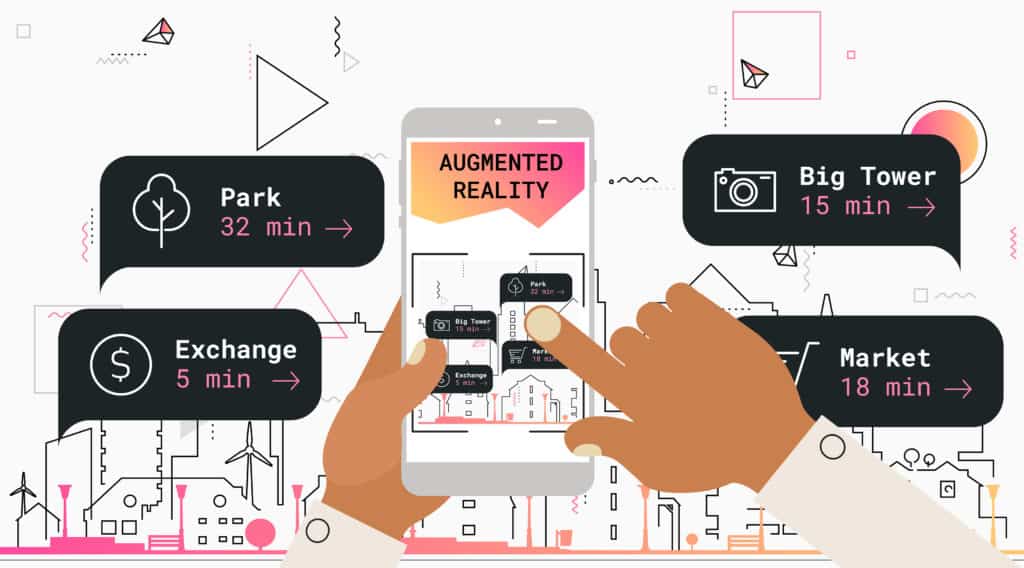
With holographic and AR applications that are driven by gestures, designers need to consider how to create gestures that are culturally acceptable to a worldwide audience. Another considerable challenge related to usability is to design in such a way that the brain easily accepts and processes the objects of this new reality.
New design patterns are evolving to cater these technologies. Designers should be able to make the elements appear in a more natural way so that the user feels more at home with this new reality. In order to create the optimal design for AI, ML and AR apps, designers need to understand how these technologies work and be a little creative. Since it is a relatively new area, there is a lot of room for innovation in design.
Integrating with other apps and services
Designing with a flexible approach in mind and allowing the app to leverage integrations is an extremely useful feature for the user. These days, a lot of startups and businesses are already using a host of communication and productivity tools like Slack, Trello and Asana. Giving your users the ability to sync and integrate these services can help provide maximum value to the user and make your app more user-friendly.
Catering to different device types
Apple released their new iPhone lineup including the iPhone 11, 11 Pro and 11 Pro Max not too long ago. The software also got a neat upgrade in the form of iOS 13, with iOS 14 scheduled to come out in the fall. A design tailored to the sharper and crispier display of these new devices will stand out much more. For instance, a mHealth app can make use of the new, more powerful front-facing camera along with the latest neural network powered A13 Bionic chip to make a more accurate symptom tracker.
There is news about an app that uses a picture of your fingertip to detect diabetes. It uses the phone’s camera and the flashlight to identify poor blood flow. If this is possible, imagine what you can do by leveraging the full power of the latest devices.
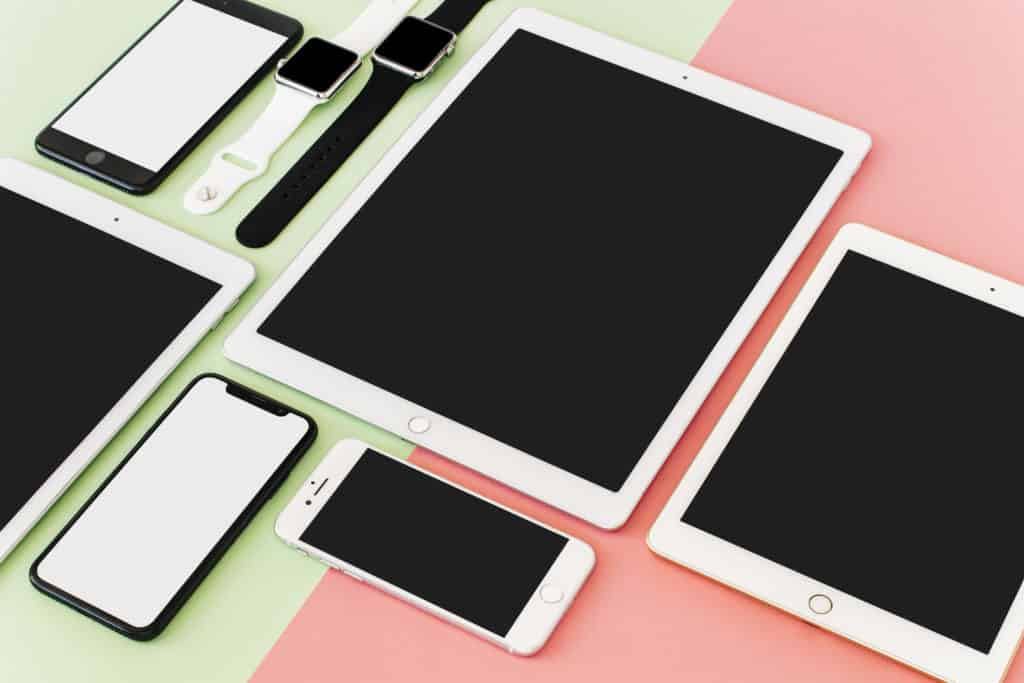
Designing for Apple and Android devices requires a deep understanding of the iOS and Android operating systems. The Human Interface Guidelines by Apple and the Material Design Guidelines by Google can serve as great examples of user interface design guidelines for mobile applications. For instance when designing your app for iOS, you have to use a tab bar for navigation as opposed to a navigation drawer for the Android version of the same app.
Apple uses sizes like 1x, 2x and 3x for its devices. For Android, designers have to make their designs compatible with 6 different screen sizes. The LDPI which is at the low end of the spectrum measures 120dpi, it is followed by MDPI, HDPI, XHDPI, XXHDPI and XXXHDPI.
With new screen sizes, taller aspect ratios (18:9), bezel-less display and notch design, app designers have to constantly be on the lookout for how their proposed design will function on the latest devices.
Faced with this constant influx of new devices, designers need to keep their designs responsive. They should test and optimize their designs for each device. A simple design that offers just the right information is critical. Know your audience and iterate the UI/UX app design based on the demographics. Also pay attention to in-app analytics for any points of frustration for users and resolve them.
Step 4: Design with the User in mind
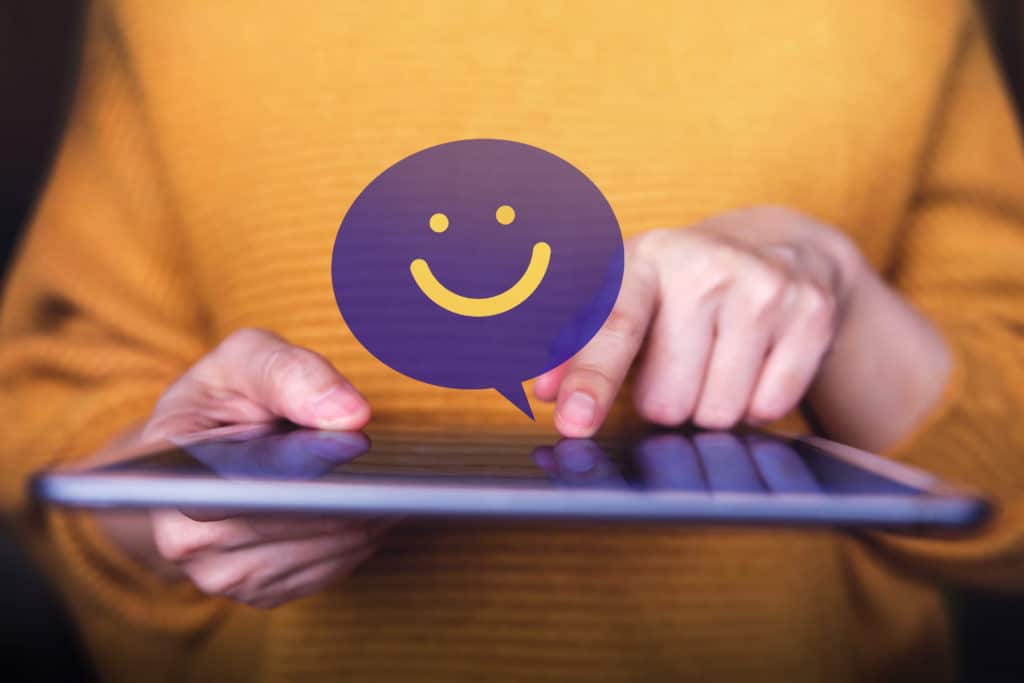
When designing your app, don’t fall into the trap of adding more and more features. Putting the user first is a great approach to creating a usable app and this varies drastically whether you’re building a chatbot, developing a marketplace app, or developing a trading and investment app. When you consider the end user, you start realizing that an app should be practical and easy to use. Start by asking yourself questions like, Who is my user? What are their problems and how can I solve them? Now align them with the business goals of your app. Once you have something, test it with the user and evaluate.
Killed by Google offers an interesting list of Google apps and services that have been discontinued now. In this list, you will find an app called Bump. It was basically an iOS and Android app that allowed users to transfer contacts, pictures, and data over the internet to other devices. Users did this by physically bumping their phones together. When the phones were bumped, a screen appeared on each device to confirm and select files. While back in 2011, transferring data to other devices was a big user need and this app offered a good solution, times have changed.
In the words of Bump Technologies CEO David Lieb, “The next generation of mobile apps will solve problems in a way that the user, the customer, doesn’t even have to think about it.” He goes on to say, “Mobile will enable all of these apps to kind of flip, and instead of me telling the app what I want it to do, the app will suggest to me, Hey, you might want to leave for your meeting down at the end of the strip because there’s a lot of traffic.”
Being aware of the latest industry trends also helps during the mobile app designing process so that we can create something offering maximum value to the user. Come to think of it, a trend is present because of wide user acceptance after all.

Nowadays, users just prefer apps to perform the required actions in the background instead of putting in the effort by clicking buttons or going through a whole tedious flow. In this case, a user does not want to make their phone transfer information to other devices, it just ‘happens’.
The main goal of user-centric design is to reduce the effort for the user. Your app should minimize the need to type. Signing up is a major drop-off point for users. Just offer some functionality to the user without enforcing registration. The freemium model has worked wonders for app developers just because of this reason.
Your app should have the minimum possible permission requirements and to make things more convenient for the user, just autofill their email from the app store (if required).
App accessibility
Making your app accessible to a wider audience is a must. You should consider people with disabilities when creating your design. Something as simple as adding a caption to a video can increase video engagement by up to 500%.
According to stats, around 15% of the world population lives with some form of disability. W3C or World Wide Web Consortium is an international community that develops web standards. Their Web Content Accessibility Guidelines (WCAG 2.0) lays out accessibility guidelines and best practices for online content. This document shows how these rules apply to mobile accessibility.
Apple has been constantly trying to push app developers to make their apps more accessible to all types of audiences. Dynamic text is one of the suggested practices in this direction.
Now that you are aware of the importance of app accessibility and a user-first approach to design, apply this knowledge to perfect your design. Your app should be nicely tailored to the needs of the user. Make it as user-friendly as possible by testing the design with real users and improving it based on the feedback.
Step 5: Understand the science and apply it
App design has evolved at a very fast pace. We like to constantly remind our readers that a great app design adds some value for the user. It is a design meant for growth and relies on more than just exuberant colors and animations. Taking a dive into the actual science and understanding how you can improve your design is extremely crucial.
This step offers great insight into the science of app design and how it is used to produce spectacular results. By the way, I hope you noticed that the application design steps we describe in our mobile app design guide are numbered just for convenience and not ordered by importance.
Check Out: The Manifest Highlights Topflight Apps as Best Reviewed UX Designer for 2022
Importance of UX principles
As a founder, User Experience (UX) design is not something you can shy away from. Don Norman coined the term UX in the early 1990’s. So much research has been done in this area that sometimes it is hard to actually keep up. You can even do a whole specialized degree in User Experience Design. Here we give you three must-know principles that form the core of UX design.

Hick’s law
The more choices you give to a user, the more time will be consumed in making that decision.
Parkinson’s Law
This law states, “If you wait until the last minute, it only takes a minute to do” or in other words “The longer you give a task, the longer it takes”. In the context of app design, know that users don’t have a lot of time to complete a task. You must ensure that the instructions and actions in the app are meaningful and quick. This principle easily applies to the sign-up or onboarding experience of an app.
KISS Principle (Keep It Simple Stupid)
Unnecessary complexity and features should be avoided. Your app will work best if it is kept simple and it stays true to its core feature.
For example, consider our healthcare app ‘TYGON Lyte’. While it offers three main features namely therapy, detection and sanitizing, our UX team identified light therapy as the core value proposition. Based on this insight, a practical and simple design of the home page was created that focused strictly on light therapy.
If you want to learn more about UX you can check out this pretty handy site, Laws of UX.
Consistent branding
This point is a pretty obvious one. We mention it for the sole purpose of highlighting just how pivotal it is to keep the designs of the application consistent with its web counterpart. The icons, graphics, typography and even the most minute details have to be perfectly aligned with each other.
Color Theory
To understand color psychology, you must take a look at the color wheel. It can be divided into two distinct halves. The warm colors are the likes of yellow, orange and red. Blue, green and similar colors are called cool colors.
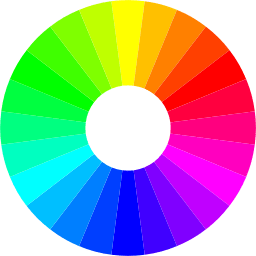
Complementary colors lie at the opposite sides of the wheel, e.g. Blue is the opposite of orange. You must have noticed that many popular apps and logos make use of these opposite color combinations as they help make things stand out.
Earlier we discussed the importance of accessibility, keeping it in mind, avoid using too many green and red color combinations as it is the most commonly reported pair that causes problems for color blind people. Interesting fact, Facebook is blue because Mark Zuckerberg is green-red colorblind and he sees blue the best.
There is also a complete marketing guideline on the emotional response that certain colors trigger. Yellow is associated with being youthful and optimistic. It can be used to attract the attention of a casual user to purchase something. Blue is associated with trust and security. Banks as well as different businesses applications often use blue for this very reason. It is also suitable when designing and developing healthcare apps. Similarly, green is mostly associated with finance and wellbeing apps. It is known to be a relaxing color for the eyes. Applications related to luxury products or services often use black due to its sleek and powerful nature.
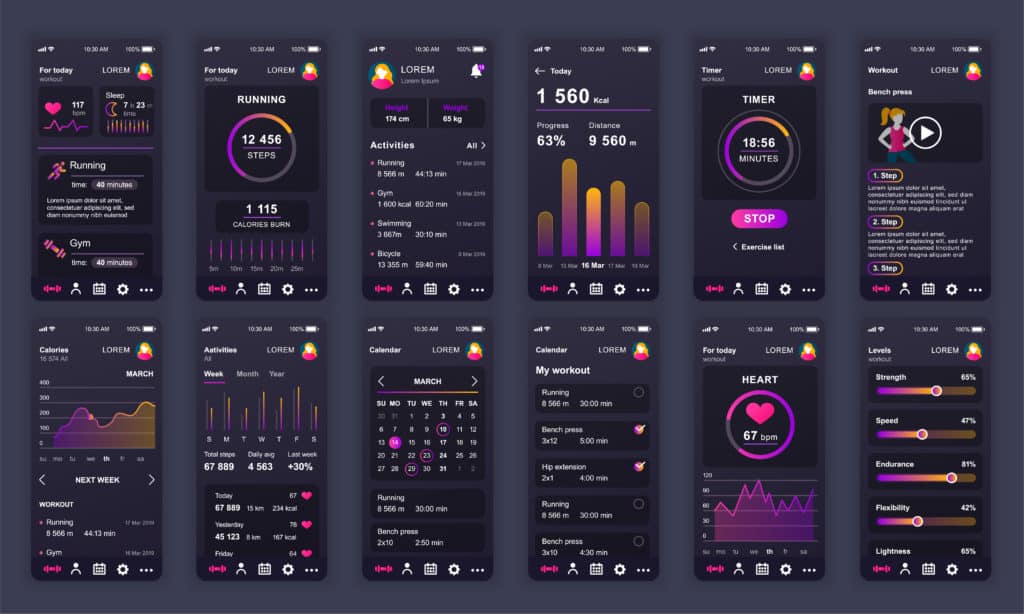
The color theory suggests that the important content should be in high contrast. While this makes it more distinguishable, overdoing it throughout the app may cause strain for the user. On the other hand, low contrast techniques are a designer favorite as they make for some beautiful layouts. Try to find a sweet blend between readability (high contrast) and attractiveness (low contrast).
There is no denying how important the proper usage of color is. Staying true to its vision of discovering and expanding knowledge for the benefit of humanity, NASA has done quite some research on the topic of color usage. They even offer free online resources for the public to benefit from their research.
Focusing on the color of a button may seem trivial to some. In fact, it has been proven that user testing and perfecting the color of a call-to-action button results in a considerable spike in conversions.
Minimize cognitive load
Cognitive psychology principles have rightly found a place in the design process. Reducing the cognitive load, i.e. the amount of effort required to complete a task, can work wonders in making the app something users love.

Intrinsic cognitive load is the energy required to absorb new information while also knowing what task to perform. For example, the user should be given instructions in a clear and short manner. The CTA (call-to-action) should be on the same page and the user should not have to navigate between screens to make the decision.
Extraneous cognitive load should be reduced in the design. This is anything that is not related to the task at hand and is consuming mental resources. Generally, it is the result of bad design, like misplaced fonts, overload of content or using inappropriate colors.
To reduce cognitive load, avoid visual clutter and make the design simple. The human brain quickly accepts layouts and patterns that it already knows. This is why in most apps, we see nearly the same pattern for commonly used features like signing up.
Step 6: Perfecting the in-app experience
Designing for empty state
The first interaction with the app should make the users comfortable and offer them a glimpse of what is to come. This is where a thoughtfully crafted on-boarding mobile user experience comes in.

Designers will focus a lot on the filled or populated design of the app and often neglect the naked, initial design of the app that the new user encounters. There are a number of ways to make this empty state more meaningful. A guided tour of the app can be a wonderful place to start for the user. In some other cases, offering an editable sample entry (like in a dummy item in an e-commerce app) can prove to be pretty handy for the user.
Earlier on we learned about the principle of intrinsic cognitive load. Keeping in mind this principle, the welcome note offered to the user should be short and offer a well-placed call-to-action.
One-hand navigation or thumb-friendly layout
Spend some time considering one-hand navigation as you go through mobile app design process steps. Place the actionable elements in the zones of the screen where the thumb can naturally reach. The tap targets should have a large enough size to allow easy tapping. Do not place different tap targets very close to each other.
Always use proper spacing. Ideally, the preferred size for a tap area is between 7 to 10 mm. The top of the screen is a hard to reach area and in the case of larger screens, it requires a change of grip. Position destructive actions like deletion in places that are hard to reach so that the danger of accidentally using it is mitigated.
Proper navigation and visual hierarchy
A good design ensures that navigating through the app is as painless as possible. Users have a natural tendency to remember the first and last items in a series. This phenomenon is called the Serial Position Effect. According to research, the recall ability is affected by the position of an element in a series. The human brain finds it difficult to recall the elements in the middle of the series.
Due to this reason the latest designs favor a top bar navigation or a bottom bar navigation as opposed to hamburger menus. The most important items are placed at the right or left of the navigation bar.
Having a clear visual hierarchy is also very important. Visual hierarchy is defined as the size of elements on a screen. Generally, the more important elements are given more weight.
Step 7: Future proof your mobile UX design
Change is constant and undeniable. Make your design flexible enough to cater for new changes even if that means a marginal increase in initial app development costs. It should also remain relevant and continue to provide value to the user. This is the case for the custom app development process in general, be it the idea, the design or development phase.
Importance of content
Words used within the app have an enormous impact. Use easily understandable words and avoid unnecessary information. The best sequence and structure is the one that is easy to read for your user.

Typography is also one of the most powerful elements of the design. It can make an app more user-friendly and accessible. Just recently, I started using this cloud-based note taking app called ‘Bear’. It’s available for Apple devices only (iPhone, iPad and Mac). I fell in love with this app at first sight. I ditched the native notes app by Apple and completely switched to Bear. So, what evoked such a strong reaction from me? It was the sheer simplicity and beautiful typography of the app! The designers have managed to present the powerful features of the app in such a natural and simple way that users simply enjoy using it.
Avoid copying other designs
It is simply not worth trying to copy an existing design. You can certainly take inspiration from the best of the best but copying is a big no. Every app is unique in its own way. Only you know the specific use case which you are targeting and the value that you want to provide. Other designs will not suffice in providing that value to the user as you desire. In the end, the rewards of creating a distinct design for your app are worth all the time and resources that go into it.
Don’t be afraid to innovate
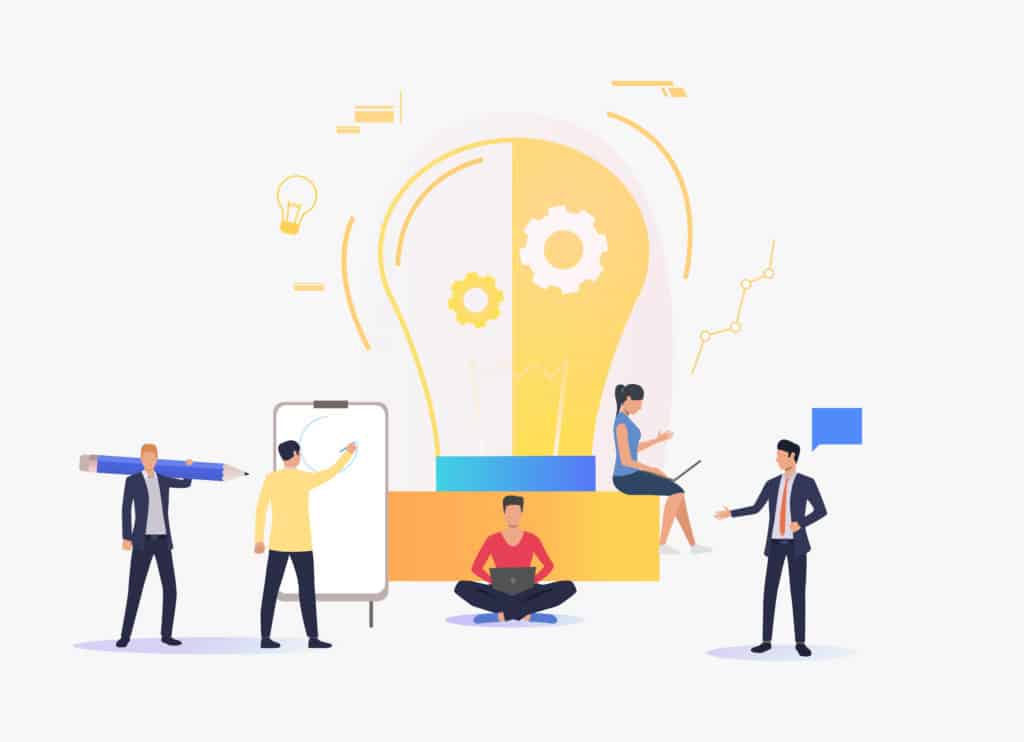
Mobile App UI Design Process + You
Congratulations! you are now equipped with the knowledge to create an extraordinary design for your app. You are one step closer to achieving the app that you desire.
Do keep in mind that design is an open-ended field. Although we have listed some principles and best practices, the best designs might not always apply all of them. Things like mobile application design guidelines by Apple and Google are only practical to a certain extent. Oftentimes, solving a unique use case results in a fresh and innovative design. Never be afraid to experiment with new things because there is no knowing what wonderful product you might end up creating.
At the same time, following the process of designing an app we’ve outlined in this comprehensive guide you will avoid most common user interface and experience pitfalls.
Do you need help designing the app of your dreams? We’re app developers in NYC, LA, Miami, and our team is here to help you. Reach out to us now for a free development and design consultation. Let’s design a mobile application that speaks your customers’ language.
Related Articles:
- How much does it cost to design a mobile app
- Healthcare App Design Guide
- Mobile First Web Design Guide
- How long does it take to develop an app
- Guide to React Native UI design
- Why Building the Perfect Mobile App Design is a journey
[This blog was originally published in September 2020, but has been updated for more recent data]
FAQ
What are the crucial mobile app design steps?
User testing, getting development team feedback, designing for accessibility, designing for many screens.
Can I use the same app design for iOS and Android?
We recommend sticking with Apple’s and Google’s UX Guidelines, and they differ. People are used to specific experiences on both platforms, and that implies using slightly differing designs.
What service do you recommend I use for user testing?
Usertesting.com
What other advice do you have for perfecting the in-app experience.
Make sure you are offering a consistent experience to users. That includes sticking with the OS typical gestures for going to a previous screen, etc.
